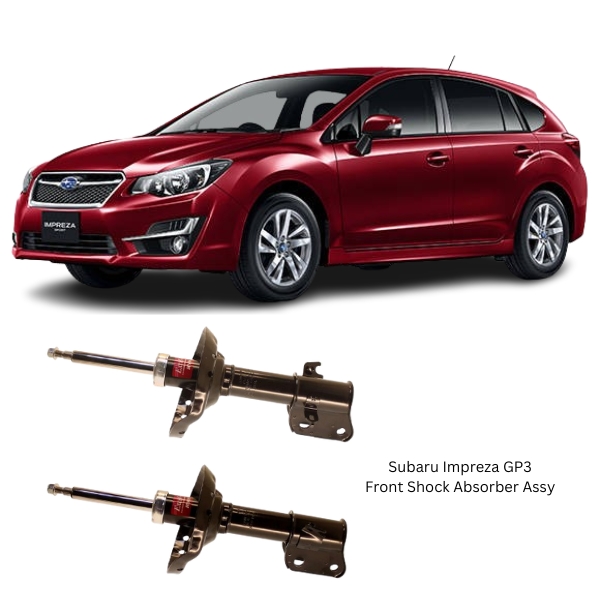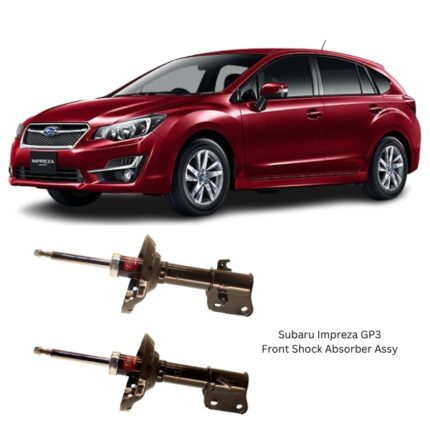Get Subaru Impreza GP3 Front Shock Absorber Assy 339387 in Kenya
The Front Shock Absorber Assembly is a critical component of a vehicle’s suspension system, designed to enhance ride comfort, vehicle control, and overall driving safety. Found on the front axle of a vehicle, it plays a central role in absorbing and dampening the impact of road irregularities, such as bumps, potholes, and uneven surfaces, ensuring that the vehicle maintains optimal tire contact with the road at all times.
Core Function and Purpose
The primary function of the front shock absorber assembly is to control the rebound and compression of the suspension system. As the vehicle moves over a rough surface, the springs in the suspension compress and decompress. Without shock absorbers, the energy stored in the springs would cause the vehicle to bounce excessively, resulting in a rough and unstable ride. The shock absorber assembly mitigates this by converting kinetic energy into thermal energy, usually through hydraulic fluid resistance, and dissipating it effectively to minimize oscillation.
Key Components of the Assembly
A typical Front Shock Absorber Assembly is made up of several integrated parts, each contributing to its performance:
-
Shock Absorber (Damper)
This is the main component responsible for damping oscillations. It consists of a piston that moves inside a cylinder filled with hydraulic fluid or gas. The internal resistance created by the fluid controls how quickly the suspension compresses or rebounds. -
Coil Spring (Optional in some designs)
In many designs, especially MacPherson struts, the coil spring surrounds the shock absorber. It provides structural support, carries the vehicle’s weight, and absorbs larger impacts. -
Mounting Brackets and Bushings
These components connect the shock absorber to the vehicle’s chassis and suspension system. The upper mount typically attaches to the vehicle frame or strut tower, while the lower mount connects to the control arm or steering knuckle. -
Dust Boot and Bump Stop
A rubber or plastic dust boot covers the piston rod, protecting it from dust, debris, and corrosion. The bump stop prevents the shock from over-compressing and damaging itself when encountering severe impacts. -
Piston Rod and Seal
The piston rod extends out of the shock body and is connected to the upper mount. The seal prevents fluid leakage and ensures smooth operation of the piston inside the shock absorber. -
Strut Mount (if applicable)
For strut-type assemblies, the top mount often includes a bearing that allows the strut to rotate as part of the steering system. This is crucial for vehicles with front-wheel steering.
Working Mechanism
The front shock absorber assembly operates using hydraulic or gas-charged principles. When the wheel encounters a bump, the shock compresses, forcing hydraulic fluid through small orifices or valves inside the piston. This movement creates resistance, which slows the compression and prevents the spring from bouncing back too quickly. As the wheel returns to its normal position, the shock absorber extends and the process is repeated in reverse.
Gas-charged shock absorbers include pressurized nitrogen gas to reduce foaming of the hydraulic fluid. This improves responsiveness and consistency, especially during high-speed or off-road driving.
Signs of a Worn or Failing Front Shock Absorber Assembly
Over time, the front shock absorber assembly can wear out due to constant stress, heat, and exposure to road contaminants. Common symptoms of failure include:
-
Excessive bouncing after hitting a bump
-
Nose-diving during hard braking
-
Poor handling or steering response
-
Uneven tire wear
-
Fluid leaks on the shock body
-
Clunking or knocking noises when driving over rough terrain
Ignoring these signs can lead to reduced vehicle control, longer braking distances, and damage to other suspension components.
Benefits of a Functional Front Shock Absorber Assembly
A properly functioning front shock absorber assembly offers several important benefits:
-
Enhanced Ride Comfort
Smoothens out road imperfections and reduces vibrations felt by passengers. -
Improved Steering and Handling
Maintains tire contact with the road, ensuring precise steering and stable cornering. -
Safety and Control
Reduces braking distance and minimizes body roll during turns or emergency maneuvers. -
Extended Tire Life
Prevents uneven tire wear by keeping the tires firmly planted on the road. -
Protection of Suspension Components
Minimizes stress on other parts like control arms, ball joints, and tie rods.
Types of Front Shock Absorber Assemblies
There are different types of front shock absorber assemblies depending on the vehicle design:
-
MacPherson Strut Assemblies
Common in modern cars, especially front-wheel-drive vehicles. They combine the shock absorber and coil spring into one integrated unit that also supports steering loads. -
Double Wishbone Systems
These systems use separate shock absorbers and springs. They are more complex but offer superior performance, especially in sports and luxury vehicles. -
Coilover Assemblies
A performance-oriented variant where the spring is mounted around the shock absorber. These are adjustable and often used in racing or off-road applications.
Material and Build Quality
The build quality of a front shock absorber assembly directly influences its lifespan and performance. Premium assemblies use hardened piston rods, high-grade hydraulic fluid, and precision-engineered valves. The outer casing is often powder-coated or zinc-plated to resist corrosion. Rubber bushings used for mounts should be durable yet flexible to reduce road noise and harshness.
Maintenance and Replacement
Although shock absorbers are designed to be durable, they do wear out over time. It’s recommended to inspect them every 20,000 to 30,000 kilometers and replace them typically around 80,000 to 100,000 kilometers, depending on driving conditions. For optimal results, it’s best to replace front shock absorbers in pairs to maintain balance and even performance.
Regular maintenance includes checking for leaks, listening for unusual noises, and visually inspecting mounts and bushings. Keeping the assembly clean and free from mud or road salt can also prolong its service life.
Installation Considerations
Replacing a front shock absorber assembly requires proper tools and mechanical knowledge. Important steps include:
-
Lifting and safely securing the vehicle
-
Removing the wheel and accessing the shock mount bolts
-
Compressing the coil spring (if separate from the shock)
-
Replacing worn components with new ones
-
Torqueing all bolts to manufacturer specifications
After installation, it is advisable to perform a wheel alignment to correct any changes in suspension geometry.
Follow us on Facebook for more parts.




